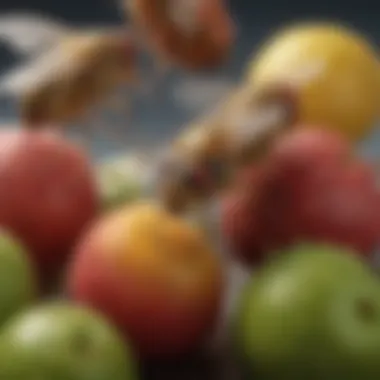Effective Strategies to Eliminate Fruit Flies at Home


Intro
Fruit flies are more than just annoying pests; they can be potential vectors for various pathogens, posing a risk to human health. Identifying and eliminating fruit flies effectively requires an understanding of their biology and behavior. They thrive on fermenting fruits and vegetables, and a meticulous approach is required to rid your home of these tenacious insects. This article aims to provide strategies that not only address the immediate issue but also pave the way for long-term prevention.
Biology and Behavior of Fruit Flies
Fruit flies, scientifically known as Drosophila melanogaster, are small, winged insects commonly found in households. They are attracted to ripe or decaying fruits, vegetables, and even sugary liquids. Their life cycle is remarkably short, allowing a single pair to generate hundreds of offspring in a few weeks. Understanding this lifecycle can guide effective control tactics.
Common Breeding Grounds
Terminating these pests requires identifying their common breeding grounds within your home. Typically, these include:
- Kitchen sinks and drains: Organic matter accumulation can be an inviting environment.
- Trash cans: Especially those with residue from fruits or other food scraps.
- Under fruit bowls: Leftover spills can provide perfect opportunities for fruit flies to thrive.
By ensuring cleanliness in these areas, the chances of an infestation can be significantly reduced.
Preventative Measures
a
Adopting preventive measures is essential. Simple habits can effectively guard your space against these pests. Here are some effective strategies you might find helpful:
- Store fruits and vegetables in the refrigerator when possible.
- Ensure trash cans are not overflowing.
- Regularly clean kitchen counters and sinks.
Maintaining diligent cleanliness can limit places where fruit flies can breed and thrive.
Traps and Remedies
The fighting back versus fruit flies may require a multi-faceted approach that involves using traps and various natural remedies. For instance, methods involving vinegar traps made with a bowl of apple cider vinegar covered with plastic wrap punctured with small holes can attract and secure these pests. Additionally, using a mixture of soap water can destroy flies by effectively trapping them.
Essential Cleaning Habits
Consistent cleaning habits can ensure that your home remains a hostile environment for fruit flies, inhibiting their ability to breed and multiply.
Engaging in regular cleaning routine that incudes:
- Wiping surfaces with appropriate cleaning products.
- Regularly checking and disposing of overripe fruits.
- Cleaning any spills quickly, especially sugary ones.
Implementation of these strategies fosters a fruit fly-free household.
In summary, understanding the habits, anatomy, and breeding preferences of fruit flies is key to developing an effective strategy for exterminating them within your living space. Moreover, ensuring sustained cleanliness paired with potential traps would guard you against future visits from these unwelcome pests.
Understanding Fruit Flies
Understanding the nature of fruit flies is key to maintaining a pest-free home. These insects might appear small and insignificant, but their impact on hygiene and comfort can be substantial. Gaining insight into their biology, life cycle, and habits can empower homeowners to tackle infestations effectively. This knowledge allows for targeted strategies tailored to disrupt the breeding process and reduce attractants within living spaces.
Biology and Behavior
Fruit flies, widely known in scientific circles as Drosophila melanogaster, exhibit a simple yet intriguing biological structure. Adults are approximately 1/8 inch long, have reddish-brown bodies, and distinctive red eyes. The remarkable adaptations they possess contribute to their rapid reproduction and resilience.
Behaviorally, fruit flies prefer dark, warm, and damp environments. They are often found in kitchens, dining areas, and near food materials. Their propensity to gather around ripe or decaying fruit and other organic matter manifests instinctive food-seeking behaviors, significantly increasing their likelihood of invading spaces where food is stored.
Life Cycle
A crucial aspect of fighting fruit flies lies in understanding their life cycle. The process begins once mating occurs, with a female capable of layng up to 500 eggs during her short lifespan. Eggs are usually laid on moist surfaces, commonly fruit skins or under bins. The initial egg stage culminates in larval development, where they feed voraciously on media-rich in sugar.
In warmer conditions, the entire life cycle from egg to adult can span just over a week. A better comprehension of this rapid life cycle enables effective response strategies; faster results can be attained when addressing the factors contributing to breeding and early egg-laying events.
Attractants and Breeding Habits


Fruit flies are primarily attracted to a myriad of sources, predominantly organic materials such as fruits, vegetables, and other decaying plant matter. Their olfactory senses are finely tuned, enabling them to detecht ripened produce from significant distances.
Typical breeding environments may include:
- Fermenting fruits or vegetables
- Overripe bananas or tomatoes
- Organic waste in garbage cans
- Dirty dishes left out overnight
Their preference for sugary and decaying matter presents a clear avenue of preventive measures. Paying attention to these breeding habits is essential for breaking their cycle and alleviating infestations inside homes. Giving attention to suboptimal food storage practices can reflect a significant part of the dissolution plan for managing intrusive flies.
Identifying the Problem Areas
Identifying the problem areas in your home is crucial for effectively controlling fruit flies. Understanding where these pests breed and thrive can lead to enhanced strategies for eradication. Notably, addressing specific locations of infestation enables you to implement focused and efficient measures. Decluttered and clean spaces reduce the chances of attracting fruit flies, minimizing future occurrences and maintaining an overall pleasant environment.
Common Sources of Infestation
Fruit flies often emerge from a variety of unsettling sources within the household. Here are some common areas to examine:
- Ripening and Rotting Fruit: As the name suggests, these pests are commonly drawn to fruit products. Even small bits left in a bowl may be sufficient.
- Uncovered Food Products: Without proper confinement, food items may become hotspots for fruit flies. Sugary snacks, beverages, and produce continue to attract their presence.
- Kitchen Drains: Decomposing organic matter builds up here, acting as serious sources for fruit fly habitation. Regular cleaning of these spaces is thus vital.
- Garbage and Waste Containers: Similar to drains, an absence of frequent cleaning within bins contributes to being nutrient-rich for these pests.
- Compost Bins: Improper management turns this eco-friendly setup into an ideal breeding ground for fruit flies. Balancing compost items ensures less attraction appears.
Recognizing these inflection points can assist in narrowing down the path for eradication. Frequent vigilance establishes essential awareness among food lovers concerning their domestic environment.
Signs of a Fruit Fly Presence
Identifying the signs of infestation can provide valuable data indicating the presence of fruit flies. Key signs include:
- Visible Adult Flies: An initial sight of small, flying insects hovering around kitchen areas or near fruit.
- Larvae Observations: Often recognized as small, white maggots in food or associated areas pointing toward breeding tendencies.
- Egg Deposits: Tiny gel-like masses noticeable on surfaces of ripe or overripe fruits or vegetables.
- An Unpleasant Odor: Fermenting or ripening produces distinct smells accompanying fruit fly activity in specific locales.
By understanding these indicators, it ensures correlation with preventative actions can be concluded in an organized and efficient manner. Monitoring these signs provides clarity in appropriatively addressing the issue before it becomes severe.
Preventive Measures
Preventive measures are crucial in the fight against fruit flies in the home. By focusing on avoidance rather than reaction, one can significantly reduce the chances of an infestation. Eating habits and household organization play a key role in strengthening a home's defenses against these pests. With effective preventive strategies, you can minimize the appeal of your living space to fruit flies and strengthen cleanliness routines, thereby promoting a more pleasant and healthy environment.
Proper Food Storage Techniques
Storing food properly is essential in reducing the attraction for fruit flies. Fruit should not be left out in the open. Instead, keep it in the refrigerator or in sealed containers. Baking goods like bread should also be stored in airtight containers. Increasing vigilance around ripening fruits and vegetables can be effective. When buying in bulk, purchase only what will be consumed promptly to avoid the spoilage that attracts these pests. Soft foods, especially overripe produce, act as prime breeders if left uncovered.
To keep food properly organized, here are some effective techniques:
- Keep a strict rotation schedule for produce. Consume older items first to prevent them from spoiling.
- Limit the number of perishable items left on countertops. Arrange them in a fridge or designated food storage basket.
- Use clear containers labeled with expiration dates to streamline refrigerator contents.
By applying these tactics, the allure of Your home to fruit flies can be drastically reduced, providing a head start in preventing infestations.
Cleaning Habits to Adopt
Cleaning habits play a significant role in pest prevention. Regular cleaning helps mitigate germs and food residues on surfaces. Set up a consistent cleaning schedule, focusing on areas that may be prone to spills or food remnants, guaranteeing surfaces are pest-free. It is ideal to eliminate any potential breeding sites.
Here are some simple daily and weekly tips:
- Daily: Wipe down countertops after cooking and meal preperation. Sweep or vacuum floors to collect crumbs.
- Weekly: Empty and clean the trash cans.Regularly clean the kitchen, including behind appliances where food particles can accumulate.
- Immediate Action: Deal with spills immediately, using cloth or sponge to prevent sticky residues attracting arthropods.
Adopting diligent cleaning habits establishes a framework for escaping fruit fly attraction and ensuring your food spaces remain inviting for moments of culinary appreciation, not for An unwanted infestation.
Managing Compost and Garbage
Arranging compost and garbage correctly plays an essential role in ensuring success in pest avoidance. Organic matter attracts fruit flies due to its decomposing nature. To minimize problems, consider using airtight compost bins designed for the convenience of managing waste without allowing accessibility for pests.
When dealing with compost and regular garbage, adopt these mindful strategies:
- Choose a compostbin with a secure lid to deter entry.
- Rotate compost frequently. Plenty of air circulation prevents it from overly compact, helping to reduce odors.
- Dispose of daily waste quickly, ensuring rubber-banded kitchen bags prevent any smells wafering upwards.
- Even consider a sealed countertop compost container for successful diversion of organic waste filtration. Many newer models reduce odors they produce effectively.
These segway carefully managed waste streams, discerning fruit sutures before the hatch. Proper cleaning habits paired with intelligent waste management proves effective against fruit flies, keeping spaces thoughtful and harm-free.


Effective prevention based on proper storage, rigorous sanitation practices, and intelligent waste management provides an insurmountable bulwark against fruit flies seeking entry into residence.
Trapping Methods
Trapping methods represent a fundamental part of a fruit fly elimination strategy. These approaches are useful as they not only catch the pests but also serve as indicators of an underlying problem in the home. Setting traps can help manage the population and provide insights into the success of other control methods.
Using traps can offer several advantages. They often work without chemical pests' killers, making them safer for households with children, pets, or allergy-prone individuals. Furthermore, they are usually simple to deploy, utilizing household items or easily acquired commercial products. Monitoring the traps regularly can inform users of new breeding hotspots, maintaining a proactive approach to pest management.
DIY Traps Using Household Ingredients
Vinegar and Dish Soap Trap
The vinegar and dish soap trap is a widely used option in fruit fly management. This method harnesses the attraction of fruit flies to vinegar, a substance they find appealing. When combined with dish soap, a key characteristic of this trap emerges: dish soap breaks the surface tension of the vinegar, causing the flies to drown upon landing.
What makes this trap particularly beneficial is its reliance on commonly available household ingredients, making it accessible to a broad audience. Due to its simplicity, anyone can create one with minimal effort. The vinegar and dish soap trap suits numerous environments — ranging from kitchens to dining areas.
However, users should consider a unique aspect: the trap's effectiveness may vary depending on the type of vinegar used. Apple cider vinegar tends to be more attractive than white vinegar to many fruit flies. While this trap poses few disadvantages, it does require regular monitoring—noticing when vinegar needs replacement or if it has become ineffective.
Fruit and Funnel Trap
The fruit and funnel trap uses a piece of overripe fruit placed at the bottom of a container with a funnel-shaped top. The main contribution of this method is visual attraction, capitalizing on a specific fact that fruit flies are drawn to decomposing produce. The funnel serves a unique purpose, allowing flies to enter the container but making escape difficult due to its narrow neck.
This trap is advantageous in that it is even simpler than an alternative approach, using excess fruit from the home instead of needing to purchase new materials. The effluvia from the rotting fruit draws in flies that infers that this trap works effectively in well-fly-populated areas.
Nevertheless, there can be drawbacks. The nature of this setup might allow for non-target insects, complicating the user’s findings. Additionally, this trap can attract more fruit flies before they begin to die or get caught. Regular replacement of fruit may be necessary, ensuring continual effectiveness, as moldy fruit ceases to attract.
Commercial Traps and Solutions
Commercial traps exist for users seeking tailored solutions. These are designed with specific pheromones or attractants to enhance performance against fruit flies. Kits typically come with user-friendly guides making them easy to set up and understand.
Some commercial traps might employ sticky surfaces to catch flies in a straightforward manner. Others, such as traps that utilize EPA-approved solutions, offer added reassurance, ideal for households with sensitivities toward poisons or harsh chemicals.
Consideration is vital regarding the overall lifestyle. Depending on the generations or style of the host family, some might choose the ease of these traps or prefer DIY markers based on availability and personal conviction. Living space dynamics, rules about dealing with organic waste, and individual preferences influence these decisions ultimately.
"Effective trapping can both control existing pest populations and aid in early identification of potential new bredding grounds."
Natural Remedies
Natural remedies play a crucial role in the comprehensive effort to eliminate fruit flies from the home. They offer a means to address pest problems while being mindful of health and environmental impacts. Many chemical solutions can be harsh and present risks to both personal well-being and ecological stability. In contrast, remedies from nature often pose fewer risks, aligning well with sustainable living practices.
Natural strategies can be just as, if not more effective than traditional methods. They provide a way to weave pest control seamlessly into daily habits. When deploying these methods, long-term success hinges on integration, consistency, and a solid understanding of the properties of the ingredients used.
Essential Oils as Repellents
Essential oils are effective and pleasant-smelling alternatives that can repel fruit flies. Specific oils, like peppermint, eucalyptus, and clove, emit scents that are disliked by fruit flies while being harmonious to human health.
Here are several benefits of using essential oils:
- Low toxicity: Unlike synthetic pesticides, essential oils are generally less toxic to humans and pets.
- Pleasant aroma: They can enhance indoor air quality, making spaces smell fresh and inviting.
- Multi-purpose: Essential oils serve multiple purposes beyond repelling insects, including relaxation and mood enhancement.
To use essential oils against fruit flies, dilute a few drops with water in a spray bottle. It's advisable to spray around problem areas, particularly near trash bins and fruit bowls. Additionally, consider adding a few drops to cotton balls and placing them strategically throughout your home.
Herbal Remedies and Their Efficacy
Herbal remedies can also yield positive outcomes for controlling fruit fly populations. Certain herbs like basil, mint, and bay leaves contain compounds that can deter these pests. Using fresh or dried herbs in your kitchen can assist in managing fruit fly trouble while providing some culinary benefits as well.
Here’s how these herbs work:
- Basil: Its strong aroma can disturb the fruit fly's ability to locate food sources.
- Mint: Similar to basil, its strong scent can regulate fly populations and contribute positively to diverse dishes.
- Bay Leaves: Often placed in cupboards and stored items, certain essential compounds help keep flies at bay.


A simple strategy involves mixing chopped herbs into a bowl and placing it where flies tend to congregate. Many people find high levels of success using herbal deterrents in tandem with cleaning efforts.
In summary, natural remedies like essential oils and herbs not only combat fruit flies effectively but do so while encouraging an eco-friendly and healthier living environment.
Long-term Control Strategies
Implementing long-term control strategies is crucial for maintaining a fruit fly-free environment. This aspect of fruit fly management ensures that once these pests are eliminated, they do not return. Establishing comprehensive strategies not only addresses the current infestation but also minimizes future risks. Considerations about consistent diligence in cleaning, effective storage, and ongoing monitoring play pivotal roles in this approach.
Regular Maintenance and Inspection
Routine inspection is a cornerstone of any effective long-term control strategy. By regularly checkng areas in the home where fruit flies could breed or hide, you can quickly identify and address potential sources of infestation. Here are some key points to help in this practice:
- Inspect items carefully: Always check bags of produce for signs of fruit flies before bringing them home.
- Check containers regularly: Look inside trash cans, recycling bins, and compost boxes frequenty to ensure nothing is attracting pests.
- Schedule cleaning days: Dedicate specific times for thorough cleaning of kitchen areas and other locations where food is present.
By making Regular maintenance and inspection part of your routine, you can keep a close eye on potential issues and resolve them proactively.
Creating an Unwelcoming Environment
An important part of keeping fruit flies at bay is making your home less inviting to them. Several simple strategies can be implemented to achieve this effect. Consider the following:
- Reduce moisture: Fruit flies are attracted to not only fruit but also moisture. Ensure pipse, faucets, and drains are leak-free and that spills are cleaned promptly.
- Limit accessible food: Store all food in airtight containers. This makes it harder for fruit flies to reach their targets.
- Proper waste management: Keep trash bins sealed and compost securely covered.
By taking these mitigation steps, you significantly dampen the appeal of your home to fruit flies.
In sum, proactive control measures curtail the likelihood of new infestations while sustainig a cleaner living environment.
When to Seek Professional Help
In addressing a fruit fly infestation, there will often come a point where one might feel overwhelmed with the situation. While many strategies can tackle the problem on a smaller scale, there are circumstances that warrant the involvement of professionals. Recognizing when to enlist expert help is critical.
Recognizing Severe Infestations
Identifying a severe infestation involves a few key indicators. These include:
- High numbers of fruit flies - If you observe swarms flitting around your kitchen or other areas of your home, it signals a concerning population growth.
- Reproductive behavior - Spotting fruit flies actively mating or laying eggs indicates a thriving breeding ground.
- Persistent odor - An unpleasant smell emanating from hidden areas like trash bins or behind appliances suggests decaying organic matter, which invites fruit flies.
These signs indicate it is no longer a problem you can easily handle on your own. The potential of a widespread infestation demands more robust measures from trained professionals.
Choosing the Right Pest Control Service
When deciding to engage professional services, it is essential to select a reliable pest control company. Look out for the following considerations.
- Reputation - Search for companies with positive reviews. Experiences of others can guide your choice. Check platforms such as Reddit or local social media.
- Methods Used - Inquire whether they use integrated pest management strategies. This demonstrates a balanced approach focused on long-term prevention rather than merely extermination.
- Licensing and Certification - Verify if technicians are knowledgeable and allowed to operate at a professional level. This usually ensures a thorough understanding of pest control regulations and practices.
- Customer Support - Effective communication is vital. Choose a service that offers clear explanations and follow-ups regarding your specific situation.
Involving professionals should always be the last resort. However, knowing when to make that choice can save time, resources, and additional headache. As fruit flies can adapt quickly and reproduce in large numbers, their management sometimes requires expert knowledge to ensure thorough elimination.
For more insights into effective pest control measures, consider exploring resources like Wikipedia or Britannica.
End
In the context of this article, the conclusion plays a crucial role in summarizing the main strategies and insights discussed regarding the elimination of fruit flies in your home. It compiles the key points and emphasizes the significance of a multi-faceted approach to dealing with these pests.
The cultivation of awareness surrounding the biology, behavior, and breeding habits of fruit flies, as explored in earlier sections, provides a foundation for effective pest control. Understanding these aspects permits homeowners to identify and target major sources of infestation within their own kitchens and living areas.
Effectively preventing fruit flies requires diligence in several areas:
- Proper food storage techniques can restrict access to potential breeding grounds.
- Cleaning routines, particularly in kitchen areas, safeguard against attracting fruit flies.
- Monitoring both compost and garbage facilitates a proactive stance against recurring issues.
In addition, trapping methods featured an interesting array of both natural and commercial options. DIY approaches can combine common household items with personal touch, while branded traps provide convenience for those seeking immediate fixes. Understanding the natural remedies, like essential oils, allows us to adopt eco-friendly practices to complement more traditional pest control methods.
For situations escalting beyond typical household stuff, recognizing when to seek professional help is vital. This involves discerning the severity of infestations, alongside making informed choices regarding pest control services suited for specific circumstances. Often, expert assistance can catalyze and streamline the path to returning to a pest-free home.
Overall, consistent maintenance and adopting preventive strategies create an unwelcoming environment for fruit flies. Diligence in these areas not only promotes immediate relief but offers long-term solutions, preserving the tranquility of your food environment. By implementing these recommendations carefully, individuals can manage their surroundings in a more harmonious way, significantly reducing the probability of fruit fly infestations.
Controlling fruigt flies is not just about getting rid of them; it involves establishing practices to keep your home free from these nuisances, ensuring your living space remains pleasant and inviting.
Taking the time to apply these researched strategies enhances the chances of success against fruit flies and benefits any keen food lover. Whether you're a culinary enthusiast or a casual home cook, a fruit-fly-free space is paramount for preserving the quality of your ingredients and enjoyment of preparing delicious meals.







